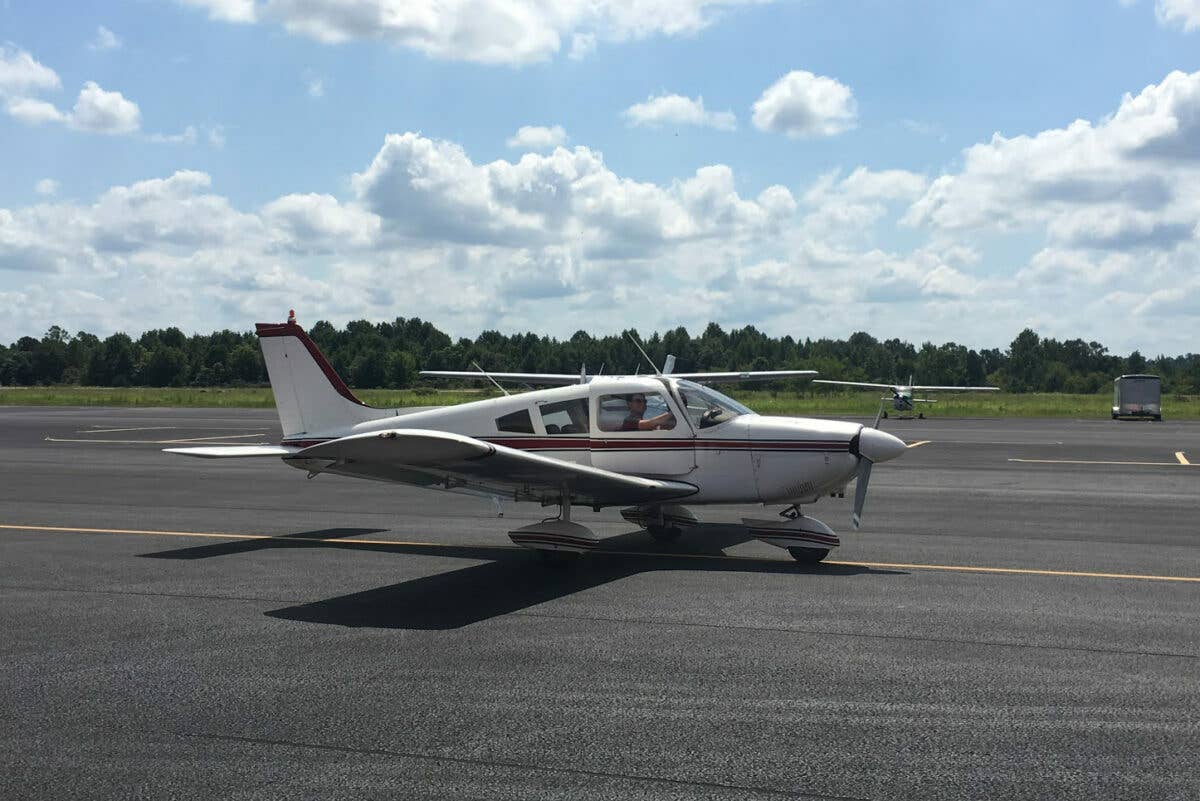Flight Instructor Dies Mid Lap in Pattern at UK Airport
Shortly after takeoff, the instructor’s head rolled back. The pilot thought the instructor was pretending to take a nap as a joke.

The flight instructor died unexpectedly while in a Piper PA-28 series aircraft, similar to an aircraft like this Cherokee 180. [Credit: Julie Boatman]
When teaching a private pilot ground school, one of the first questions you ask is, "Why are you in this class?" It is an important question because motivation is a key factor in how quickly someone learns. Over the years I have had a number of people who were in the class because their significant other was a pilot, and they wanted to know how to land the airplane if their pilot became incapacitated in flight. It is rare, but it does happen.
Earlier this month, the Air Accidents Investigation Branch—the U.K. version of the National Transportation Safety Board—released its report on the unexpected death of a flight instructor who died during a lap in the pattern at Blackpool Airport.
The report notes that "circumstances surrounding the occurrence did not fall within the definitions of an accident or serious incident as defined in ICAO Annex 13, however, the Chief Inspector, in exercise of his powers under the Civil Aviation (Investigation of Air Accidents and Incidents) Regulations 2018, initiated an investigation, treating the occurrence as an incident."
How it Happened
According to the AAIB investigation, a pilot described as "a qualified pilot" planned to fly a Piper PA-28-161(Cherokee) on the morning of June 29, 2022. The pilot planned to fly to another airfield, but after checking the weather, decided that "the crosswind was above his personal limit to fly on his own.” Still wanting to go flying so that he remained within the flying club’s recency requirements, the pilot asked an instructor if he would accompany him for a single lap in the pattern.
The instructor, age 57, held a commercial certificate and both single and multiengine instructor ratings. He had approximately 8,876 hours and was well acquainted with the pilot. The instructor agreed to fly with the pilot once he finished a trial lesson with another client.
According to the pilot, the conversations were normal during the taxi. He told the instructor he would keep the nose of the aircraft into the wind for the run-up and the instructor replied, “looks good, there is nothing behind you.” The pilot did not recall the instructor saying anything else after this point.
Shortly after takeoff, the instructor’s head rolled back. The pilot thought the instructor was pretending to take a nap as a joke. The pilot continued to fly as he did not think there was anything wrong. When the pilot turned onto the base leg, the instructor slumped over with his head resting on the pilot’s shoulder. The pilot still thought the instructor was joking with him and continued to fly the approach. The landing was normal. The pilot realized something was wrong as he started to taxi back to the apron, and the instructor did not respond to questions. The pilot signaled the airport fire crew who happened to be working on the apron that something was wrong with the instructor. The fire crew and the air ambulance medical crew, who are based at the airport, attempted to revive the instructor but it was too late. According to the autopsy, the instructor died from acute cardiac failure.
Several general news outlets picked up the story. Several of the accounts failed to mention that the pilot flying was not a passenger, but qualified to fly the airplane.
How often does pilot death in the cockpit happen?
According to a statement sent to FLYING, the Federal Aviation Administration does not have a database of inflight, general aviation pilot deaths. "We track fatalities only when they result from an accident," the statement continued.
When a pilot dies during a commercial flight, it makes the news. There are also safeguards for the passengers and other flight crew, as the copilot has the training and experience to fly the aircraft. In fact, during most scheduled operations, the pilots switch off legs during the trip.
A search of the NTSB database showed there have been a few accidents/incidents that were attributed to pilot incapacitation from a cardiac event, but compared to the number of accidents overall, they are a drop in the bucket. That's the reason they make the news—especially when there is a positive outcome.
The FAA notes that there are incidents when a passenger successfully lands an aircraft, for example, in May of 2022 at Palm Beach International Airport (KPBI), when a passenger landed a Cessna Caravan after the pilot suffered a medical issue and passed out. The FAA released a podcast and blog about that incident.
However, if you are a pilot who has been trying to persuade a friend or loved one to fly with you, stories about pilot incapacitation don't help—however, they might inspire that person to take a seminar specially designed for the non-pilot who is apprehensive about flying in a small aircraft.
Making Your Passenger Comfortable
Over the years, several aviation advocacy groups such as the Aircraft Owners and Pilots Association, and the Ninety-Nines, as well as private individuals have created short courses and seminars for people who want to become more comfortable in the cockpit.
One of those is Right Seat Ready, a course taught by FLYING contributor Jolie Lucas, who in 2009 along with pilot Jan Maxwell, developed the course to lessen the anxiety of the person flying in the right seat.
"Attending a companion flying course allows attendees not only to get information about emergency procedures, but it also leads to the enjoyment of flying and becoming an active participant in the airplane," says Lucas. "Our right seaters receive a double-sided laminated emergency checklist for use in the airplane. We have produced three or four private pilots, with number five having just soloed. In a nutshell, we lessen anxiety through education and support and increase enjoyment for all."
Lucas notes that when the course is taught at a location with an aviation training device such as a Redbird flight simulator, the participants are invited to get some time on the device to learn and practice basic aircraft control.
Some flight schools offer a variation on this technique, and there are flight instructors who will provide dual instruction from the left seat so that the passenger in the right seat gets real-world experience flying the aircraft.
The situation in the U.K. was a best-case scenario for such a tragic event as the pilot flying didn't need the help of the instructor to land the airplane. Having the CFI lose consciousness during a training flight can be a frightening experience—because of the noise and vibration of the aircraft, it is hard to tell if they've simply fallen asleep or they crossed the celestial hold short line.
Pro-tip: if nudging and verbal communication do not rouse the CFI, extend your wrist so your watch face is under their nose. If the watch face fogs up, they're still breathing. (If you don't have a watch, use the screen of your smartphone.) I have used this technique twice: the first time, I was a 10-hour student pilot, the second time as a CFII in training. In both cases, the face of the watch fogged up. Both CFIs were subsequently awakened with more forceful application of percussive communication.
AOPA’s Pinch Hitter Course
AOPA developed its Pinch Hitter Course in 1963 as the result of two accidents involving pilot incapacitation. The organization now offers an online course for cockpit familiarization.
The idea was to offer training to nonpilots (often the wives of pilots) that would enable them to navigate an airport, communicate with air traffic control, and most important of all, safely land the airplane.
The original course was designed around four hours of classroom instruction followed by four hours of flight instruction. The curriculum for the course was developed by the Ohio State University School of Aviation. Aviation educator and AOPA Project Director Ralph F. Nelson developed the course. He was warned that if the course did not draw at least five people during AOPA’s annual event in Palm Springs it would be canceled. That didn’t happen—143 women and a teenage boy showed up to take the course.
For the next several years the course continued at various venues across the country. Pilots would fly their airplanes with their family members to designated venues to take part in the training. It was noted that approximately a third of the people who participated in the training went on to earn their private pilot certificates.

Sign-up for newsletters & special offers!
Get the latest FLYING stories & special offers delivered directly to your inbox






